Raptor Reflection from Across the Pond
Posted on in In the Field by Zoey Greenberg, Former Education Intern
Voices silenced and the sound of swishing wings flooded the blind. Our faces tilted towards the sky and I felt palpable awe take over our family as we watched magnificent birds swirl against a cornflower blue sky. We were perched on wooden benches looking out onto the sheep-peppered hills of mid-western Wales while visiting Gigrin Farm Red Kite Feeding Centre, a raptor oasis and primary contributor to the rehabilitation of the red kite (Milvus milvus).
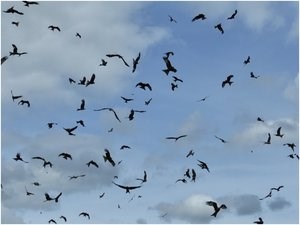
Each week the feeding center tosses out a quarter ton of sliced beef for red kites, buzzards (Buteo buteo), and rooks (Corvus frugilegus). For the price of six pounds (entrance fees pay for the on-site rehabilitation of injured raptors brought in by the public), we entered the blind of our choice and waited with the kites, gathering and perching in anticipation of man, shovel, and meat. Suddenly, we heard the rumbling of an approaching vehicle, and the kites took to the sky in a swooping ballet of excitement. As morsels were flung into the air, the birds responded in a paradox of frenzied hunger and practiced grace. They positioned themselves in a seemingly organized line, streaming towards the ground in quick succession with talons open. When successful, the kites would float up to their own pocket of air and eat on the wing, bringing a yellow foot to their curved head in an admirable maneuver of private dining.
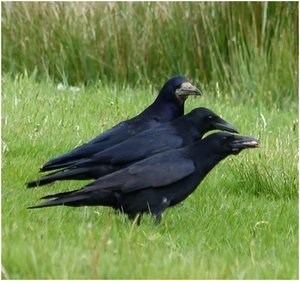
Red kites form a pecking order similar to other gregarious raptors, and the first smatterings of meat were snatched up by the eldest birds. Eventually younger kites joined the mix, followed by cautious rooks and crows. An amusing yet primal attitude of wariness hung over the field, and as I watched it became clear that each species employed their own unique set of tricks in order to obtain each snack. The corvids remained on the ground, alert but cleverly filling their crop at every opportune moment until a fat pouch formed beneath their shiny black beak. Finally, two buzzards plopped themselves down in the middle of the commotion, ducking when swooped upon but holding their ground as they gingerly hopped about, stabbing the ground with their powerful feet.
Birds danced, and time slid away. The sun dipped below the hills as the red kites continued to cartwheel towards the ground. As I surveyed the blind, I saw unanimous tranquility in the faces of my companions, and I realized that the kites leave an impressionable mark on the many minds that watch them each day, each week, each year. However, it was not always this way. In this region, concern for raptors is a heartening step forward following an era of persecution that plagued the red kites of Wales for the better part of the 18th century.
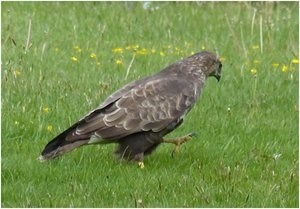
The feeding station began in 1993 at the request of the Royal Society for the Protection of Birds (RSPB) following an all too familiar story of decline. In the Middle Ages killing a red kite resulted in capital punishment. The birds were valued as street-cleaners due to their scavenging habits and were considered an integral part of landscape. However, by the 16th century, improved sanitation became a priority and the Tudor Vermin Acts were put into place. This legislature led to the establishment of a bounty on kites, as well as other raptor species.
As the kites became rare, egg collectors and taxidermists further contributed to a decrease in their numbers and by 1903 there were only a few breeding pairs left in Wales. By then, red kites had been declared extinct in both England and Scotland. In 1903, prompted by an impassioned letter written to the British Ornithologists’ Club, a self-funded group of landowners, farmers, and other concerned community members was created. Through pamphlets and the involvement of the RSPB, the last remaining nests were defended with the help of local army commanders, and attitudes towards the birds slowly began to shift. In 1989 RSPB stepped in and initiated an intensive reintroduction program to help the kites regain a foothold in their former range. The feeding station became part of this effort. Today, there are over 300 pairs in Wales alone.
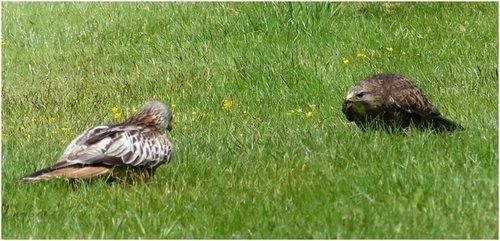
These efforts have not gone to waste, and now on any given day, as thermals swirl above the countryside, residents in Wales can look up to see the sunset-colored tail of a red kite drawing circles in the sky. This turnaround should provide an uplifting parallel to those of us working on the other side of the Atlantic Ocean to protect raptors, seeing as the kites of Wales were subjected to shooting pressures very similar to those that defined raptor numbers along the Kitattiny ridge for many years. Different country, similar trajectory.
Sadly, there are still countries where shooting and poisoning raptors is the status quo, perceived as necessary management or an acceptable pastime. All of us in raptor conservation hope that one day every species will be free to roam the skies unharmed; however, our environmental history shows us that traditions die hard, and new conservation frameworks are rarely successful when forcefully imposed. Many rural communities do not have the tools, whether tangible or otherwise, to wake up one day and alter their collective opinion on raptors. As a global conservation community supporting a group of animals that does not see borders, we must be creative and recognize the role of human perception in the success of our work. Reintroduction programs may place birds back in the sky, but if they remain unvalued by locals, their success as a species will crumble.
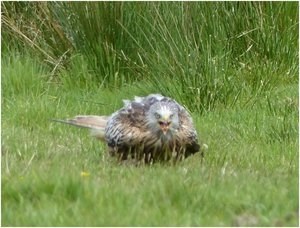
As I watched the kites that day, a calm drifted over me. Each twist of a wing was prominent but subtle, isolated but surrounded. The birds' movements felt primitive. I was witnessing a creature that creates its own wind and defines its own sky with nothing but the biological potential it was born with. While there is a chance that supplying free food to raptors creates its own side effects, it was also clear that visitors walked away from that field with a newborn fondness for the natural beauty of the raptor world. At the end of our visit, I spoke with a staff member and instantly recognized a commonality in our awe and respect for the birds. He believes in the kite’s potential for changing minds, and we concluded the afternoon swapping raptor stories, smiles on our face and agreement in our hearts. Overhead, red kites wheeled and turned, making this world a better place one dive at a time.